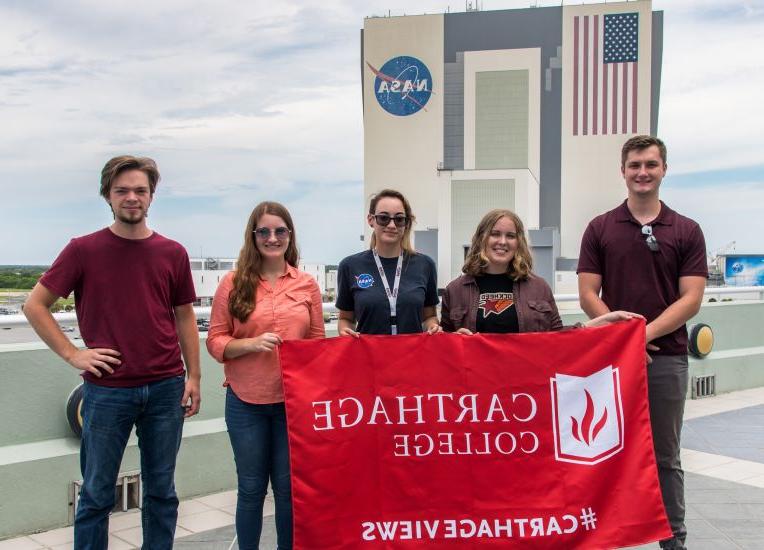微重力项目
体验零重力
Carthage students and faculty regularly conduct research aboard NASA’s zero-gravity aircraft, as part of ongoing experiments and technology development for space hardware.
Microgravity projects at Carthage are carried out in partnership with NASA researchers, 威斯康辛太空资助协会, and commercial service providers. Most projects involve a team of 4-6 students working throughout the academic year on the design, 建设, and flight of an experimental spaceflight technology or low gravity experiment. 博彩网址大全已经飞了不止一次,000 weightless parabolas on NASA and commercial research aircraft, including the NASA C-9 and Zero G Corporation G-Force One.
目前的项目包括:
- Propellant mass gauging technology development on Blue Origin’s New Shepard spacecraft
- Active slosh suppression in propellant tanks using advanced magnetic alloys
- Propellant “shape” studies in weightless environments
All projects are supported through NASA’s Flight Opportunities Program, which provides researchers with access to launch opportunities, 抛物型飞机, 以及其他测试设施.
NASA’s Reduced Gravity Education Flight Program gives students and educators the opportunity to design, build and fly an experiment in microgravity and get a look at what it takes to be a NASA engineer or scientist.
博彩网址大全微重力计划
Magneto-active Slosh Control (MaSC) — 2018-present
The MaSC project is a collaboration between Carthage 空间科学 and Embry Riddle Aeronautical University to develop a free-floating membrane to suppress slosh in propellant tanks. The membrane is a thin magnetic alloy that is actively and autonomously controlled to suppress slosh forces occurring during engine burns and other spacecraft maneuvers.
模态推进剂计量 (MPG) — 2011-present
The MPG project is a collaboration between Carthage 空间科学 and Kennedy Space Center Cryogenics Laboratory to develop a high-resolution low-gravity fuel gauging technology by exploiting the effect of fluid loading on the structural properties of liquid-filled propellant tanks.
Learn more about the MPG project
Next-generation Spacecraft Coolant — 2013
Carthage students supported the Purdue University Flow Boiling and Condensation Experiment currently manifested for launch to the International Space Station in 2020. The Carthage team developed and flew an experiment to test the capability of radial membrane filters to remove oxygen from a perfluorohexane-based coolant in low gravity.
Learn more about the spacecraft cooling project
Slosh in the Orion Service Module Propellant Tanks (2010)
In collaboration with Lockheed Martin Space Systems, Carthage students modeled the slosh dynamics of the Orion Service Module’s propellant tanks. We conducted both low-gravity flight-testing and extensive computer modeling of the slosh dynamics of propellant at different fill-levels.
Learn more about the propellant slosh project
微重力休止角 of Lunar Regolith (2009)
In collaboration with NASA Glenn Research Center, Carthage students developed and carried out experiments to measure the repose angle of lunar regolith simulants in vacuum under lunar gravity conditions aboard NASA’s reduced gravity aircraft.
Learn more about the repose angle project
Dust in the Wind: Low-gravity Inertial Filtration of Lunar Dust (2008)
Carthage worked with NASA Glenn Research Center to develop a test bed for demonstrating the use of a cyclone filter for regolith dust filtration in future spacecraft and planetary habitats. The project demonstrated the effectiveness of vortex filters in lunar gravity.
Learn more about the dust filtration project


